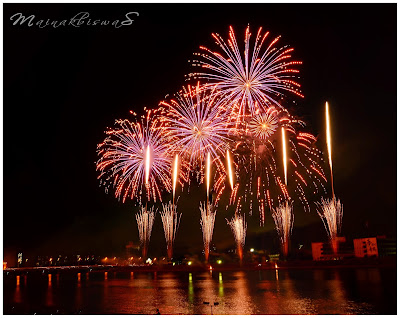Travel Photography Tips and Ideas
1. Set your camera to shoot in burst mode
Setting your camera to "burst" mode means that several shots will be taken with a single click of the shutter. This is especially helpful when you’re trying to take an action shot, like a whale breaching the water’s surface.
Also, burst mode is a good idea when handing your camera to a stranger to take your photo. You will get several to choose from, instead of just one where you’re blinking and someone is photo-bombing in the background. I always have my camera set in burst mode so we can choose our favourite photo from a series.
2. Unfocused/Blurry
Another easy method and very beautiful at night when you have colourful lights around you. On a DSLR you just have to set your lens to manual and unfocus. On your point and shoot camera, you can focus on a subject near you and then, while still holding your finger on the release button, move to the scene you want and take the picture.
3. Switch up your perspective.
Looking up — or down — can change the way you see things.
4. Add instant film.
This photo-in-a-photo idea is the fastest way to make your shot one-of-a-kind. Bring along your Fujifilm INSTAX Mini 70 (it's got a selfie mode and a selfie mirror, so it's perfect for groups and solo travel) and get creative. Juxtapose day and night scenes, or go black and white against color. Diehard iPhone photographers can do it, too: capture, edit and print pics straight from your smartphone with Fujifilm's INSTAX Share app.
5. Selfie
Some love them, some hate them, but you have to admit that you have tried it at least once. An inexpensive way to improve your selfie skills would be to get a Selfie Stick. It is optional but could improve how much you can fit in your photographs.
6. Photo Editing
You took a beautiful picture but it’s still missing that last spark that would make it amazing. You can do this by using effects. There are many ways to do this, either on your phone with apps like Snapseed or online on a website specialised in editing pictures.
7. Night photography takes patience and planning
Night photography can be super fun, but it takes a while to get the techniques down. (I'm still working on it.) Have patience, and you will improve.
Also, it takes some thought and research. You can't just expect to step outside on any night and get great night shots. You need to plan around the moon and the constellation paths and weather.
For example, when we were in Arches National Park, it just happened to be the one day of the month where the Milky Way would pass through Delicate Arch, creating a view that is famously photographed. We were there just out of luck, but many other photographers had planned their trip around this photograph.
Tip: One way to track this is by downloading SkyView app, which will tell you the exact time and course of the constellations, and will show you the chances of clouds obscuring your path.
8. Don’t be afraid of a little rain (or clouds!)
Cloudy days can sometimes be disappointing when you’re on vacation, but they often make for the most interesting photos. Clouds soften the sun’s light, acting like a natural light box, and make it possible for you to get great shots even in the peak of the afternoon. They can also create a cool, moody effect and can make your pictures more interesting than if you have a clear blue sky.
Much the same, many people get nervous to take their camera out in the rain. But rainy shots can be super interesting.
Try these ideas to get a fun, rainy day shot:
- Take a photo of people walking in the street with colorful umbrellas.
- Get a close up shot of droplets on a window, blurring the city lights in the background.
- Zoom in and get a close up of the rain droplets on flowers or another interesting surface.






Comments
Post a Comment